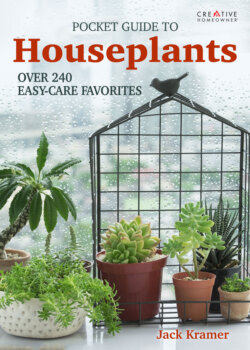Читать книгу Stitching Pathways - Jack Kramer - Страница 20
На сайте Литреса книга снята с продажи.
Plant Science
ОглавлениеWithout light, plants will die. Light is necessary for photosynthesis, the production of sugar and starches from carbon dioxide and water. How long a plant is exposed to light each day determines the amount of food that the plant manufactures and whether the plant grows well and produces flowers.
4 Rules for Light
• Most houseplants thrive where they receive bright or dappled light from a window, without direct sun.
• Plants that aren’t receiving enough light respond by “reaching” toward the light source. Their stems grow long and spindly. Rotate them.
• A south-facing window is brightest. However, south light is too intense for many plants.
• Plants need the blue, red, and far-red wavelengths of the sun’s spectrum of wavelengths; some artificial lighting emulates this quality.
Misting periodically improves humidity. To protect plants from water sitting on their leaves, hold a card over the leaves, and mist the base of the plant.
Heat and Humidity
Most houseplants like average home temperatures of 70°F to 78°F (21°C to 25°C) with a drop of 10°F (5.5°C) at night. The daily temperature difference helps plants manufacture sugar, which fuels their growth. Keep houseplants away from hot radiators, hot-air vents, and drafts.
Most homes have a humidity level of 30 to 40 percent, which is fine for most houseplants. On hot summer days, mist plants lightly with water between 11 a.m. and 1 p.m. In the winter, try to keep the humidity more in balance by employing a room humidifier or by misting the area around the containers and soil surface between 6 and 8 p.m. every other day.
Air Circulation
In the winter, when the air is drier inside than outside, ventilation helps maintain adequate humidity. Open a window slightly whenever the weather is not too frigid, or be sure there is sufficient ventilation near the plants. When it’s really cold outside and impractical to open a window, use a small fan to circulate air. In summer, air conditioning is a boon for houseplants. Most houseplants wilt in torrid weather, but air conditioning perks them up.
Resting: Like people, plants need to rest to restore their energy. Orchids, like many flowering plants, need time to rest between blooming periods. The orchid at left is resting, indicated by its slowed growth. Resting plants usually need less water. The orchid at right is actively growing and has sent out a bud.
